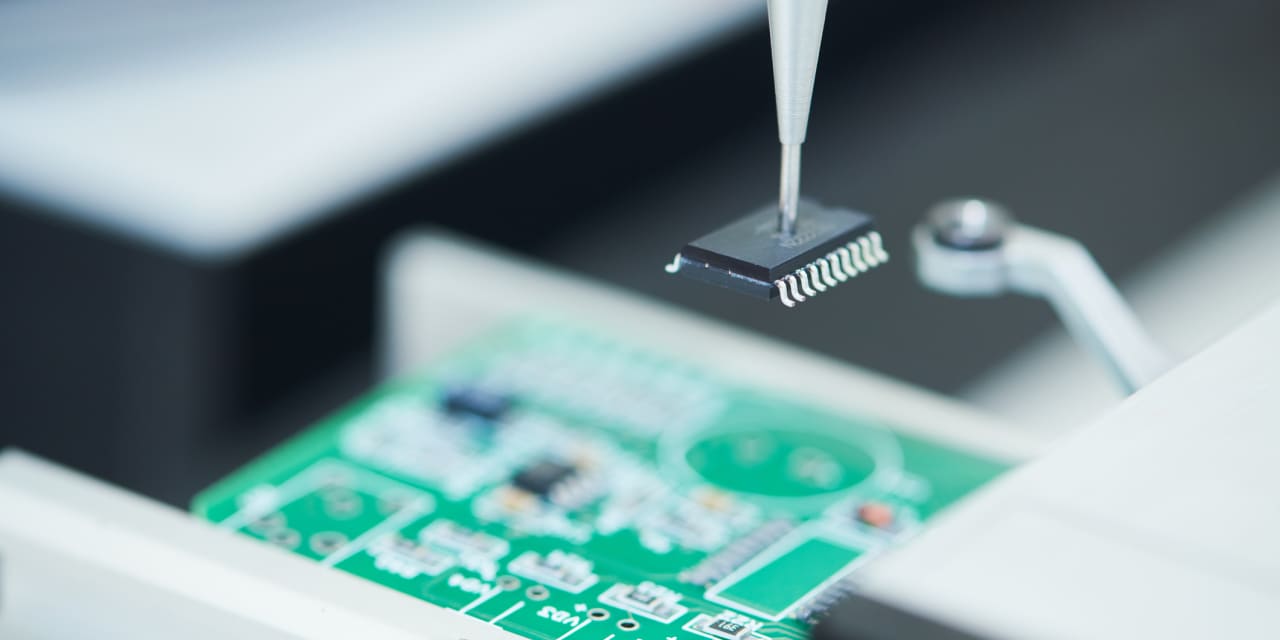Micron Technology
shares were headed lower in late trading Wednesday after the memory chip company posted weak financial results for the latest quarter but provided revenue guidance that topped Wall Street estimates.
For the fiscal fourth quarter ended Aug. 31, Micron reported revenue of $4.01 billion, down 40% from the year-ago quarter, with an adjusted loss of $1.07 a share, and a loss under generally accepted accounting principles of $1.31 a share.
Micron’s quarter came in a little above its own forecast of $3.9 billion in revenue, an adjusted loss of $1.15 a share and a GAAP loss of $1.33 a share.
For the November quarter, Micron sees revenue of $4.4 billion, give or take $200 million, which is above the old Wall Street consensus of $4.2 billion. The company sees a non-GAAP loss for the quarter of $1.07 a share, a few pennies wider than the consensus forecast for a loss of $1.04 a share.
Micron sees calendar 2023 DRAM bit demand growing in the mid-single digits. For NAND, the company now sees growth in the high teens, up from a previous forecast in the high single digits, reflecting strength in some consumer end markets.
Micron chief business officer Sumit Sadana said in an interview with Barron’s that the quarter should mark a bottom in the recent down cycle.
“We’ve reached an important inflection point,” he says. “Pricing has bottomed. We see it moving up from here and gathering momentum as 2024 moves along.”
In late trading, Micron was off 3.8%.
“Our 2023 performance positions us well as a market recovery takes shape in 2024, driven by increasing demand and disciplined supply,” Micron CEO Sanjay Mehrotra said in the company’s earnings press release. “We look forward to record industry TAM [total addressable market] revenue in 2025 as AI proliferates from the data center to the edge.”
For the full year, revenue was $15.5 billion, down 49% from fiscal 2022. On a non-GAAP basis, the company lost $4.45 a share for fiscal 2023, compared with a profit of $7.75 in the previous year.
The large loss isn’t a surprise. Micron has been hurt by weak demand for both DRAM and NAND memory chips in its core end markets—PCs, mobile phones, and data centers. The company previously projected calendar 2023 bit demand growth of low-to-mid single digits, in percentage terms, for DRAM, and high single digits for NAND, below the company’s forecast for long-term growth of midteens for DRAM and low 20s for NAND.
“Most customer inventories for memory and storage in the PC and smartphone markets are now at normal levels, consistent with our prior forecasts,” the company said in remarks prepared for its quarterly earnings call. “Inventory levels are normal across most customers in the automotive market as well. Data center customer inventory is also improving and will likely normalize in early calendar 2024. Consequently, we see demand continuing to strengthen, which has led to an inflection in pricing. Some customers have made strategic purchases in DRAM and NAND to take advantage of unsustainably low pricing as the market begins its recovery.” That last remark implies potentially lower-than-forecast unit volumes in the near term.
Sadana noted that NAND bit growth was up 42% sequentially in the latest quarter, as some customers took advantage of what they saw as abnormally low prices. He says that NAND bit volumes will be down for a few quarters while demand normalizes.
In PCs, Micron continues to forecast calendar 2023 unit volumes down in the low double-digits year over year, with low-to-mid single digit growth in 2024. Micron added that AI-enabled PCs will drive more memory demand with a refresh cycle coming over the next two years.
In mobile, Micron sees 2023 smartphone unit volume down in the mid-single digits, with mid-single digit growth in calendar 2024.
Micron added that compared to traditional servers, AI servers use significantly more DRAM and NAND chips, “with greater technology complexity, robust product value, and higher profitability.” The company said that it believes data center revenue has bottomed.
The company also said that “traditional server demand remains lackluster,” while demand for AI servers has been strong. Micron said data center customers are shifting budgets to AI servers from traditional servers. “Total server unit shipments are expected to decline in calendar 2023—the first year-over-year decline since 2016,” the company said. “We expect total server unit growth will resume in calendar 2024 to help fulfill ever-increasing workload demand.”
In response to softer demand, Micron has been slashing spending. Capital expenditure for the full year was $7 billion, in line previous guidance, down more than 40% from the previous year, with wafer fabrication equipment spending down more than 50%.
Sadana says that overall cap ex in FY 2024 will be slightly higher than the recently ended year, but with wafer fab equipment spending down, while construction spending will be up. He notes that capital spending will be driven by the addition of capacity for HBM, or high bandwidth memory, which is used in AI data center applications.
Sadana also said the company should benefit from the emergence in 2024 of AI-focused PCs and smartphones, which he notes will require considerably more DRAM and NAND than traditional hardware.
Write to Eric J. Savitz at eric.savitz@barrons.com
Read the full article here













Leave a Reply